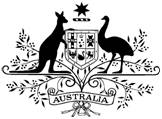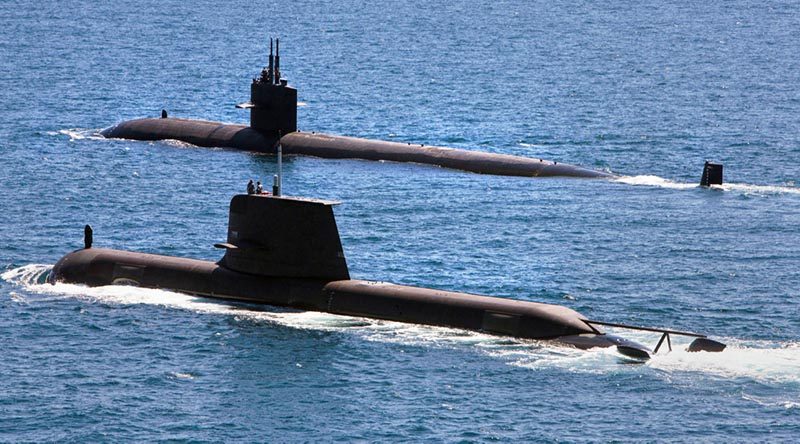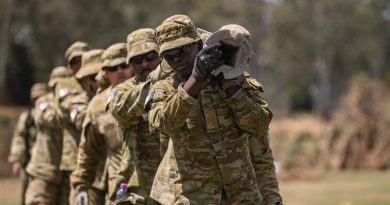Transcript – Christopher Pyne – Submarine Institute speech
Share the post "Transcript – Christopher Pyne – Submarine Institute speech"


CHRISTOPHER PYNE
Minister for Defence Industry
Leader of the House
Federal Member for Sturt
SPEECH
E&OE [OFFICIAL] TRANSCRIPT
Submarine Institute of Australia Address
16 November 2016
SUBJECTS: Defence history and spending; US-Australia relations.
Well thank you very much, Andy and it is a great pleasure to be here as part of the Submarine Institute of Australia’s conference in Canberra and thank you for the invitation to speak to you about the Government’s plans around submarines and Defence capability in general.
There aren’t many people, ladies and gentleman, who would honestly claim to have predicted the remarkable outcome of the US presidential election a week ago today; what was one of the most hard fought campaigns that I have ever witnessed, has resulted in the election of a new President, who during the campaign committed to a massive expansion of US military capability. To give an understanding of the scale of that increase, it includes 50,000 more Army troops, 70 new naval warships, 100 Air Force planes, and a dozen new Marine battalions. This represents around a half a trillion US dollar increase to the US Defence budget over the next decade. This result could bring with it remarkable opportunities for the Australian defence industry and thanks to the foresight of the current government, Australia is well positioned to grasp those opportunities.
FILE PHOTO: USS Albuquerque accompanied by Collins-class submarine HMAS Rankin (front) off Western Australia. Photo by Able Seaman Julianne Cropley.
And so this gathering comes at a crucial time. The Prime Minister’s decision to put defence at the centre of our priorities, of the priorities that I have as the Minister of Defence Industry, and the goals that we’ve set for this crucial new portfolio, mean that in a time when the United States is expanding their capability, we are similarly focused. As we’ve demonstrated throughout the year, the government is putting defence at the very centre of our National Policy Agenda. Our mission is simple: we determined to use the Defence dollar to drive a high technology, advanced manufacturing future.
This building is very much a symbol of the post-World War II optimism and the transformative power of science, of the gifts of technology. This Government wants to harness that power and drive forward into the future. Defence Industry is truly our national endeavour. We not only want to guarantee our national security and ensure that Australia can play its part in protecting peace in our own region, in Asia, in the Pacific and the Indian Ocean; we want to use Defence to underpin our economic prosperity and to put the skills and innovation that characterise our defence industries at work, to form the basis of the smart, high-tech manufacturing of the 21st century.
We want to see Defence spending assist with the transition to these new, smart industries that will drive our continued national prosperity. And this is when the jobs of the future will be created and with them the broader growth we need to ensure Australia maintains our position as an advanced economy, among the top rank of nations, and a nation not just capable of fulfilling its regional role in security as an ally that can be called upon to help when need arises.
To achieve these objectives, the Australian Government is embarking on its largest ever renewal of our defence capability. Indeed we’re making the largest ever investment in defence capability in our history. We’ll be investing just under AU$200 billion across the decade from now until 2025-26 in building that capability, growing our defence budget to two per cent at least of our gross domestic product.
Two elements will remain crucial to our success in this ambitious national endeavour. Firstly, we must manage it correctly. The scale of Defence is now vastly bigger than anything we’ve seen in modern times, and the Turnbull Government is not just beginning Australia’s but one of the world’s largest Defence expenditure processes. The project will have an impact on our national security and prosperity for decades to come. The long lead times of much of this process leaves us with no scope for complacency. Time wasted at the beginning of any project is time that must be made up at the end. That means you must get matters right from the start. We must be able to realise our ambitious goals. That is my job; that’s the role of this portfolio.
The second element of success will be our partnership with our friends and allies. I’m delighted to know that in the audience today we have Vice Admiral Jacques Cousquer, from the French Directorate General Armaments Organisation, and Rear Admiral Michael Jabaley, Programme Executive Office of Submarines for the United States Navy. It’s important to reflect that the close bonds in arms between our three nations were forged nearly a century ago. It was in July of 1918 on French soil at the Battle of Hamel in France that Australians and Americans first fought alongside each other. Notably it was the first time in the war, that American forces participated in offensive action under non-American command, using the new tactics devised by our own formidable general, John Monash, which sowed the seeds of victory on the Western Front just five months later.
That war, the First World War, was also the first time Australia deployed submarines in a conflict. Two vessels, the AE1 and AE2, forged in 1913, were dispatched to help cease the then-German territories of New Guinea on the outbreak of hostilities. The AE2 commanded by Lieutenant Commander Henry Stoker, also achieved fame for its operations in the Dardanelles, after it slipped through the elaborate Turkish defences into the Sea of Marmara on April 25th 1915, on the day of the Gallipoli landings. While the AE2 was successfully fulfilling his orders to run amok in Turkish waters, my great uncle Thomas Pyne was one of the hundreds of soldiers who lost their lives that day, as they came ashore on the Gallipoli beachside. My other great uncle Octavius served alongside him at Gallipoli, and would go onto survive Gallipoli and lose his life on the Western Front.
Australia had been one federated nation, as opposed to a collection of colonies, for just 13 years when the Great War broke out. Yet our fledgling nation did not waiver in committing forces far from home to support our allies and advance our national interests. The legacy of the AE2 operating with such success so far from our shores in support of allied operations serves as an important reminder of the vital role submarines maintain in our Defence Force today.
Acting on the findings of the 2016 Defence White Paper, the Turnbull Government has determined that Australia needs 12 regionally superior submarines with a high degree of interoperability with the United States, crafted to provide our nation with an effective deterrent and an ability to play an active part in anti-submarine warfare operations in our region. In April, following a rigorous and methodical competitive evaluation process, the Government selected DCNS of France as our international design partners. DCNS comes with a strong record after designing and building more than 100 submarines for nine different Navies, including the state of the art Barracuda fast attack submarine for the French fleet.
In September, we signed the first contract with DCNS to mobilise the resources needed to develop our regionally superior Future Submarine and commence its design. The signing of the design and mobilisation contract marks the start of the Future Submarines Program. As a crucial part of the process, we’ve already commenced work to maximise the opportunity of Australian industry involvement in the project, and the early planning for the construction of the submarines here in Australia. This focus, however, has come at the expense- has not come at the expense of our traditional allies.
As I’ve said earlier, Australia and the United States have had a long history of cooperation. With President-Elect Trump taking the helm on 20 January, I think it’s fair to say that given the consistent rhetoric around boosting military spending in the US by tens if not hundreds of billions of dollars, there will be increased opportunities for Australian defence industry. We’ve already demonstrated our commitment and our ability to develop world-leading technology like the CEA Active Phase Array Radar. This Australian technology is being exported to the world from here in Canberra, in fact, including the USA, and provides a huge step forward in radar technology.
Austal, another Australian company, has two major contracts with the US Navy. The first is for 11 Littoral Combat Ships, a contract worth approximately US$4 billion. Already, two of these vessels have been delivered and the project is on schedule. The second is for 11 Expeditionary Fast Transport Vessels with a contract value of approximately US$2 billion. Again, Austal has delivered seven of these vessels to the US Navy already, and the project is on schedule. There are many more examples of Australian Defence companies ready to take on these opportunities.
The Turnbull Government is taking responsibility for our own Defence spending as we embark on an historical Defence spend of almost $200 billion over the next decade. We have been a true friend to the United States, and I look forward to working closely with the new Defence Secretary when they are named.
Before my visit to Washington D.C. in early October, I was able to announce the selection of Lockheed Martin Australia as our preferred combat system integrator for the Future Submarines. In this role Lockheed Martin will ensure that submarine combat suite is designed and integrated to guarantee we maintain our vital interoperability with the United States, while also protecting sensitive American and Australian combat system technology. Continued(*) strategic requirements for the Future Submarines will include upgraded versions of the tactical weapons control system, which is currently being used by the Collins-class submarines as well as the Seawolf and Virginia- class vessels of the United States Navy, along with the Mark 48 Heavyweight torpedo jointly developed by the US and Australia as its main armament. This strategic approach will provide it with continuity with the tactical and weapons control systems, and the Mark 48 as key elements of the combat system of our existing submarines. Continuity with upgraded versions of the systems and weapons that we currently use as preferred capabilities for the Future Submarine ensure that Australia can continue to maintain its high level of interoperability with the United States Forces, and maintain regional superiority. But the entire combat suite for the Future Submarines will extend beyond the tactical and weapons control systems and the Mark 48 torpedo. It will also include sonar, electronic warfare communications, optical navigation, among other systems for which Australia will seek options from wider industry.
Importantly, the work required to design and integrate the Future Submarine combat system will be done in Australia. This will be just one part of the advanced high-tech work carried out on these shores to deliver Future Submarine capability. The Government believes involvement of Australian industry in the Future Submarine programs is of the utmost importance to the construction and sustainment of the submarine fleet into the future. Transferring technology and industrial capacity and growing our Defence industry to meet the nation’s sovereign capability needs will be a key objective of the Future Submarine project. As I said, the Government is determined to involve local industry as early as possible in our capacity development processes to understand just what they can contribute and how they can benefit. As part of this process, DCNS and Lockheed Martin will be leading industry days starting in Adelaide next week and across the nation throughout 2017 to maximise local industry involvement in this enormous project worth AU$50 billion alone.
Having a stronger, more resilient and capable sovereign Australian defence industry will enable the nation to be better equipped to meet our own unique challenges. These requirements will include the sovereign sustainability of our submarines throughout their long lives. To that end, in mid October, the Government also announced that we would structurally separate the ASC into three entities. These three new companies will support the key capabilities of shipbuilding, submarine sustainment, and infrastructure. The separation of ASC will deliver a more flexible approach to managing the investment required in shipbuilding infrastructure to support the Government’s historic continuous shipbuilding program. The new submarine sustainment and shipbuilding companies will continue ASC’s important role in the sustainment of the Collins-class submarines and the finalisation of the Air Warfare Destroyers respectively. The creation of these three new companies follows a strategic review of the ASC, which was conducted in 2015. The review sought to identify the best possible corporate, capital, and governance arrangements to help maximise the future success of ASC and the Australian naval shipbuilding industry. Work has already begun on the separation of the ASC into three new companies, and the full separation will be expected to be completed by mid 2017.
So we’re starting from a solid base, learning from our experiences and sustaining the Collins-class vessels, as was highlighted in the Beyond Benchmark follow-up review released just last month. In a positive pointer to the future, John Coles’s report found there’d been a remarkable improvement in the capability to successfully manage the sustainment of the Collins-class submarines. The review looked at three key areas: current Collins sustainment performance, sustainment performance during transition to the Future Submarine, and improving beyond the benchmark. The review highlighted that a program once considered a project of concern should now have to be treated as an exemplar project. As I said at the time, this is a strong endorsement of the capability of Australia’s defence industry, and those involved should be commended for their success transforming a project facing significant issues into one that now stands as a shining example of what our Defence sector and support industries can achieve. The report reiterates that we have the capability and skills to deliver large and complex Defence projects, a skills base the Government intends to nurture and expand.
Yet while we can be confident taking the lessons and skills of the Collins-class forward and applying them to the delivery of the Future Submarines, we cannot be complacent. The Future Submarine Project will be a national endeavour of a size and scale never before witnessed in Australia. Its technological demands will far outstrip anything we have ever seen before. It will require us to harness the collective skills of all [indistinct] in our Defence and wider industrial base, while also leveraging the expertise of our trusted international partners. This, of course, is where the Defence Industry Policy Statement comes into play. It brings Defence Forces, the Federal Government, and the state and territory administration together in a way never attempted, to advance both our national security and prosperity. The Government intends to grow enduring capability and foster innovation, technology transfer and develop research and development collaboration with industry, universities, and other research institutions and organisations to maximise economic benefits.
So as part of this task, I will soon be launching in early December two new initiatives: the Centre of Defence Industry Capability and the Defence Innovation Hub. The Centre for Defence Industry Capability will be based in Adelaide and backed by AU$230 million over the next decade, charged with the task of bringing all the groups I just mentioned together to deliver better outcomes to both industry and Defence. The centre will provide a suite of business support services to help our industry’s international and global supply chains and find new ways to maximise their involvement in Defence capability. At the same time, the Government will also invest $640 million in the 10 years to 25-26 in the Defence Innovation Hub to collaborate on innovation activities that will allow us to take projects from initial concept stage through prototyping and testing and into service. And we’ll also invest a further $730 million in next generation new technologies which will be in the hands of Alex Zelinsky, the head of the DSTG. [Indistinct] have a close watching brief(*) to see what he’s doing.
[Laughter]In closing, let me reiterate the vital role that submarines play in our national security. They are powerful instruments to deter conflict, and a potent weapon if needed. Today, Australia possesses a highly capable and effective submarine force built up by the efforts of many of you here today, and bringing it into being hasn’t been easy. I’m sure I’m not telling you anything there. Neither will the task of delivering the next generation of regionally superior submarine capabilities for Australia, but we remain of the strong view submarines are an essential part of our nation’s naval capability.
At the same time, we’re also determined to build a close, more strategic relationship with industry that will enhance both the nation’s economic prosperity and security. We’re determined to use the Defence dollar to drive a high technology advanced manufacturing future for our nation, and I’m here to make this vision real and to see that it happens. We’ve already accomplished much this year: advancing the Future Submarine Program and drastically improving the reliability and availability of the Collins-class submarines. So the foundation blocks have been put in place. We’ll need to muster the collective efforts of our nations to ensure the Future Submarine Program along with the Government’s broader national shipbuilding strategy is delivered successfully. That’s my job as the Minister for Defence Industry, and we’re all partners in this task together. Thank you very much.
.
.
.
.
.
.
.
.

.
.
Share the post "Transcript – Christopher Pyne – Submarine Institute speech"






